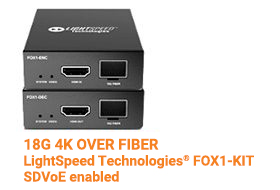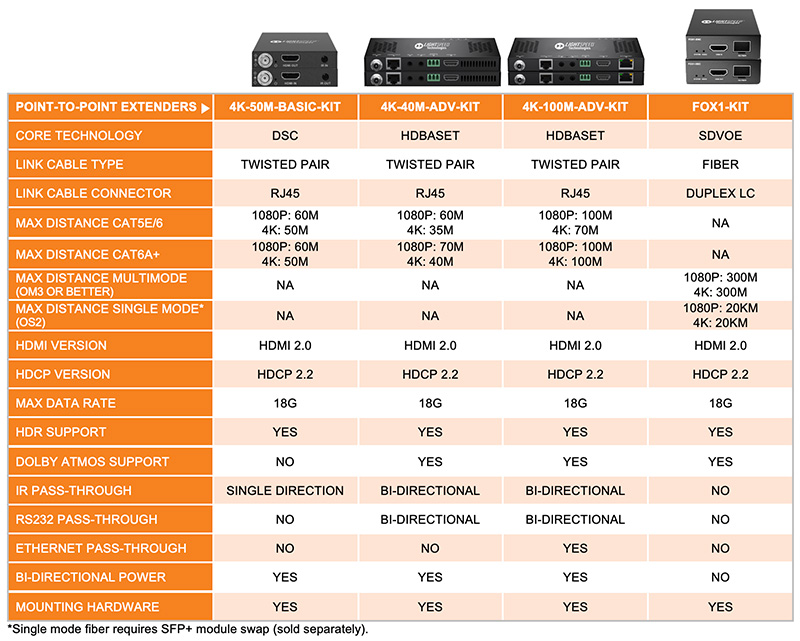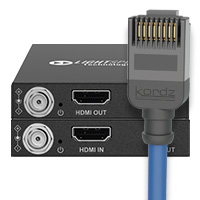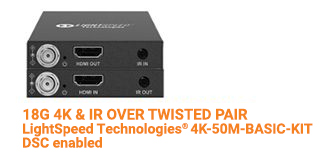Audio-visual extenders used to be simple. Choose a balun based on connector format, connect a twisted pair cable, and signals flow from point A to point B. At least that was the theory…. and it worked fine until HDMI and high-definition video came along.
Today, baluns — those ubiquitous black boxes that balanced and transmitted AV signals — have been replaced by digital extenders that feature powerful, signal specific processing that tackles audio, video, control, networking, and even power over a single cable. And while modern extenders certainly simplify HDMI signal distribution, the different chipsets and processing they employ can be confusing. We’re often asked what’s the best technology to use: DSC, HDBaseT, or SDVoE? After all, no one wants to install a service call.
Unfortunately, there isn’t a simple good-better-best answer: all three technologies have pros and cons, and all three technologies are relevant to different applications.
DSC Technology
Basic HDMI extenders employ DSC or display stream compression. Introduced by VESA in 2014, DSC was designed as a “visually lossless” form of compressing high-bandwidth digital signals in a manner which a viewer cannot discern the difference between the native and the processed image. DSC is basically an eye test that’s subjective to the viewer; it doesn’t account for digital artifacts or image blurring.
While not perfect — especially in a testing lab setting — DSC is extremely widely deployed in high-definition electronics, including computers, monitors, set-top boxes, televisions, image processors, receivers, and, of course, extenders. This wide adoption makes DSC hardware one of the least expensive technologies used in HDMI over twisted pair extenders.
In fact, DSC is so widely used and accepted that it’s a primary technology for HDMI 2.1 8K120 HDR processing including 4:2:0 chroma subsampling.
So when should DSC-based extenders be used? Considering DSC processed video isn’t perfect, it is best suited on smaller displays where motion video is typically viewed (think standard TV applications). DSC is also an excellent choice in budget-sensitive applications, as the cost of DSC-based extenders are typically less than those using other technologies.
DSC is not ideal on larger displays where artifacts are more readily identified and, frankly, it doesn’t have the processing horsepower to handle multiplexed data over longer distances. Therefore, most DSC-based extenders won’t support bi-directional IR, bi-directional RS232 or Ethernet over longer distances. That job is best left to HDBaseT or SDVoE technology.
HDBaseT Technology
HDBaseT is the second and most predominant technology leveraged by HDMI extenders. Governed by a non-profit alliance made up of industry leaders such as Samsung, Sony and LG, HDBaseT leverages an internet protocol-like approach to extending and managing high-bandwidth digital signals. Six different signal types — audio, video, control, ethernet, USB and power — are merged through HDBaseT processing into a single digital stream compatible with a single twisted pair cable.
And unlike DSC, HDBaseT supports fully uncompressed, zero-latency high-definition audio and video even over distances up to 100m (328 feet).
In addition to signal quality, HDBaseT also provides the advantage of standardization and interoperability. Devices deploying the same HDBaseT specification (there are three current HDBaseT specifications) and DC power circuit are compatible, even across different manufacturers. In practice, this means an HDBaseT-based transmitter could directly connect to an HDBaseT-based projector or display. However, most real-world consumer applications rely on point-to-point extenders as a bridge between source and destination devices.
So when should HDBaseT-based extenders by used? Well, in a bunch of applications:
- When image quality is important. HDBaseT’s uncompressed high-definition signal support ensures native, pristine audio and video even over extended distances.
- When large monitors, projectors, televisions and displays are integrated. HDBaseT isn’t prone to the same visual artifacts present with DSC technology, and artifacts are typically most evident on large format screens.
- When longer transmission distances are required. HDBaseT supports twisted pair cable lengths up to 100m (328 feet), though some extenders reduce this distance to decrease cost on power circuits (and, therefore, decrease the cost of the extender set).
- When signals other than audio and video are required. HDBaseT processing embeds and simultaneous extends bi-directional IR, bi-directional RS232, Ethernet and USB over the same twisted pair cable transmitting audio and video.
HDBaseT’s premium performance does come with a price, and HDBaseT-based extenders often cost more than their DSC-based counterparts. Additionally, HDBaseT circuits are prone to electromagnetic interference and a high-quality shielded twisted pair cable terminated with shielded connectors is recommended.
SDVoE Technology
SDVoE is the third technology leveraged by HDMI extenders and, like HDBaseT, it’s governed by a rapidly expanding industry alliance. Arguably one of the latest and fastest growing standards, SDVoE targets true AV over IP transmission deployed in point-to-point, point-to-many and matrixed applications.
 Similar to HDBaseT, SDVoE delivers uncompressed and zero-latency high-definition audio and video, embedded bi-directional IR, embedded RS232 control, embedded Ethernet, embedded USB and interoperability between devices and manufacturers.
Similar to HDBaseT, SDVoE delivers uncompressed and zero-latency high-definition audio and video, embedded bi-directional IR, embedded RS232 control, embedded Ethernet, embedded USB and interoperability between devices and manufacturers.
However, unlike HDBaseT, SDVoE is truly based on internet protocol standards, allowing SDVoE-based devices to operate with network switches and other network-compliant devices. For example, point-to-point extenders can route through switches and even connect to other SDVoE-based devices on the network.
Additionally, a fully deployed SDVoE system typically requires less hardware and is less expensive than one based on HDBaseT technology, and SDVOE circuits are more resilient against electromagnetic interference even when integrated with standard unshielded twisted pair cable and connectors.
SDVoE’s standards-based approach also makes it more attractive for different media types, such as optical extension, and many of the first mass-market HDMI over fiber extenders are leveraging SDVoE technology.
So when should SDVoE-based extenders be used? In short, SDVoE technology is viable in all the HDBaseT target applications: it delivers image quality, transmission distance, embedded control and embedded Ethernet. SDVoE is also perfect for fiber-based HDMI extension (think very long cable runs) and signal transmission through network switches.
From a cost perspective, SDVoE technology is comparably priced to HDBaseT technology, and budget-sensitive installations will still benefit from DSC enabled extenders.
Choosing an HDMI Extender Technology
So, what’s the best HDMI extender technology? Again, that depends on the application constraints:
- Extender Unit Price: DSC is the least expensive technology.
- Image Quality: DSC compresses video which can be prone to artifacts, whereas both HDBaseT and SDVoE extend fully uncompressed, zero-latency signals.
- Transmission Distance: HDBaseT extends signals up to 100m (328 feet) over twisted pair cable and SDVoE goes even further with distances up to 20km (12 miles) using fiber.
- Embedded Control & Ethernet: DSC offers limited control signal embedding, whereas both HDBaseT and SDVoE support bi-directional IR, bi-directional RS232, Ethernet and USB.
- Cable Quality: HDBaseT requires high-quality shielded twisted pair cables and connectors, and DSC and SDVoE are better options if cable type or quality are an issue.
The good news is LightSpeed Technologies® manufactures HDMI extenders using DSC, HDBaseT and SDVoE technology. The below chart explores several of the most popular extender kits, and the complete lineup of products is available at www.futurereadysolutions.com.




